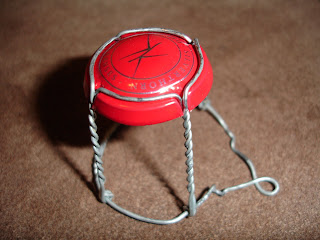
Wine fanatics often collect labels from bottles they have consumed, in contrast, Champagne afficionados take this past-time up a few notches - they collect muselets.
The earliest Champagne closure was primitive and totally ineffective. Bottles were sealed with pieces of wood and oil soaked cloth which were then dipped in wax. This method proved a failure at suppressing the almost 6 atmospheres of pressure in the average bottle and the result was frequently exploding stoppers and leaking resulting in flat wines. This was counteracted by the use of cork in the late 17th century. In order to secure the corks they were tied down with hempden string. This was a manual technique and it became very difficult to keep pace the ever increasing production demand.
In 1844 Adolphe Jacqueson invented the wire and hood or muselet (museler in french means muzzle) This consisted of a prefabricated metal plaque and a wire cage. Various shapes and numbers of 'legs' around the neck were tried before the the four-legged modern muselet was settled on. In 1906 Pol Roger took the functional muselet to the next level when it was customized and branded by use of lithography. Branding and packaging is one of the successes of Champagne and the detail and design on muselets is spectacular. Not surprising that it has lead to the existence of the Placomusophile or simply the muselet collector. Considering that there are well over 5000 champagne producers alone excluding all the other forms of sparkling wine producers from Cava to Cap Classique it should be more than a life times endeavour. I suspect the best part of the quest is actually drinking the bubbly.
I find this kind of trivia not only fascinating but vital. Learning the name of an object, understanding and knowing its history and putting it in context all gives it meaning and importance. A humble throwaway object acquires relevance and existence in our consciousness.

No comments:
Post a Comment